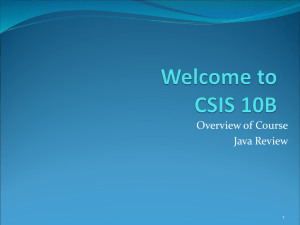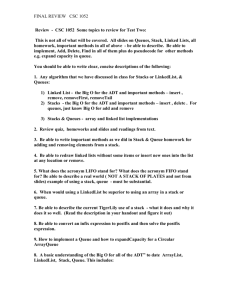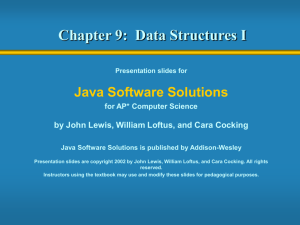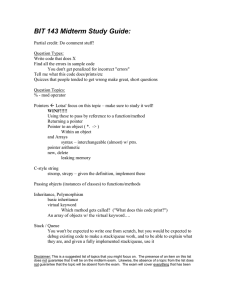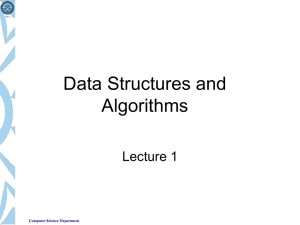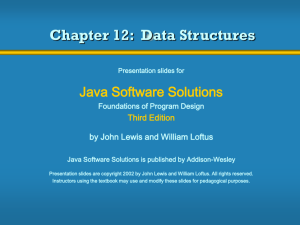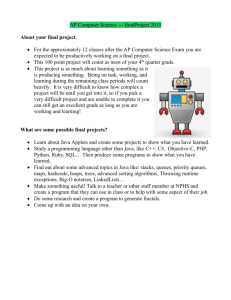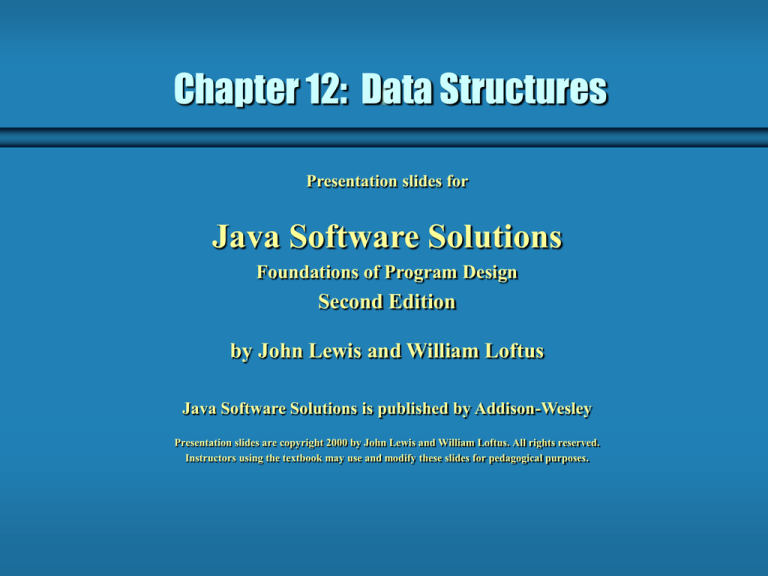
Chapter 12: Data Structures
Presentation slides for
Java Software Solutions
Foundations of Program Design
Second Edition
by John Lewis and William Loftus
Java Software Solutions is published by Addison-Wesley
Presentation slides are copyright 2000 by John Lewis and William Loftus. All rights reserved.
Instructors using the textbook may use and modify these slides for pedagogical purposes.
Data Structures
We can now explore some advanced techniques for
organizing and managing information
Chapter 12 focuses on:
•
•
•
•
•
dynamic structures
Abstract Data Types (ADTs)
linked lists
queues
stacks
2
Static vs. Dynamic Structures
A static data structure has a fixed size
This meaning is different than those associated with the
static modifier
Arrays are static; once you define the number of elements
it can hold, it doesn’t change
A dynamic data structure grows and shrinks as required by
the information it contains
3
Object References
Recall that an object reference is a variable that stores the
address of an object
A reference can also be called a pointer
They are often depicted graphically:
student
John Smith
40725
3.57
4
References as Links
Object references can be used to create links between
objects
Suppose a Student class contained a reference to another
Student object
John Smith
40725
3.57
Jane Jones
58821
3.72
5
References as Links
References can be used to create a variety of linked
structures, such as a linked list:
studentList
6
Abstract Data Types
An abstract data type (ADT) is an organized collection of
information and a set of operations used to manage that
information
The set of operations define the interface to the ADT
As long as the ADT accurately fulfills the promises of the
interface, it doesn't really matter how the ADT is
implemented
Objects are a perfect programming mechanism to create
ADTs because their internal details are encapsulated
7
Abstraction
Our data structures should be abstractions
That is, they should hide details as appropriate
We want to separate the interface of the structure from its
underlying implementation
This helps manage complexity and makes the structures
more useful
8
Intermediate Nodes
The objects being stored should not have to deal with the
details of the data structure in which they may be stored
For example, the Student class stored a link to the next
Student object in the list
Instead, we can use a separate node class that holds a
reference to the stored object and a link to the next node in
the list
Therefore the internal representation actually becomes a
linked list of nodes
9
Book Collection
Let’s explore an example of a collection of Book objects
The collection is managed by the BookList class, which
has an private inner class called BookNode
Because the BookNode is private to BookList, the
BookList methods can directly access BookNode data
without violating encapsulation
See Library.java (page 500)
See BookList.java (page 501)
See Book.java (page 503)
Other Dynamic List Implementations
It may be convenient to implement as list as a doubly linked
list, with next and previous references:
list
11
Other Dynamic List Implementations
It may also be convenient to use a separate header node,
with references to both the front and rear of the list
list
count: 4
front
rear
12
Queues
A queue is similar to a list but adds items only to the end of
the list and removes them from the front
It is called a FIFO data structure: First-In, First-Out
Analogy: a line of people at a bank teller’s window
enqueue
dequeue
13
Queues
We can define the operations on a queue as follows:
• enqueue - add an item to the rear of the queue
• dequeue - remove an item from the front of the queue
• empty - returns true if the queue is empty
As with our linked list example, by storing generic Object
references, any object can be stored in the queue
Queues are often helpful in simulations and any processing
in which items get “backed up”
14
Stacks
A stack ADT is also linear, like a list or queue
Items are added and removed from only one end of a stack
It is therefore LIFO: Last-In, First-Out
Analogy: a stack of plates
15
Stacks
Stacks are often drawn vertically:
push
pop
16
Stacks
Some stack operations:
•
•
•
•
push - add an item to the top of the stack
pop - remove an item from the top of the stack
peek - retrieves the top item without removing it
empty - returns true if the stack is empty
The java.util package contains a Stack class, which is
implemented using a Vector
See Decode.java (page 508)
17
Collection Classes
The Java 2 platform contains a Collections API
This group of classes represent various data structures used
to store and manage objects
Their underlying implementation is implied in the class
names, such as ArrayList and LinkedList
Several interfaces are used to define operations on the
collections, such as List, Set, SortedSet, Map, and
SortedMap

